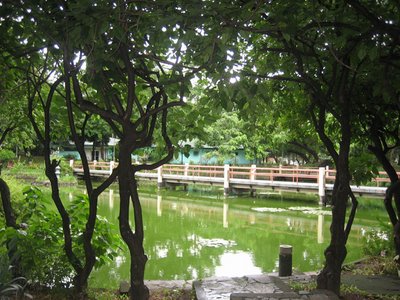 It wasn’t in our plans. In fact, it was for something else — a book launching cum poetry reading — that we were at La Salle Taft last Saturday. But we arrived very late for the event so we decided to go elsewhere after lunch and tête á tête with the author (para naman hindi sayang ang lakad at porma namin, hehe).
It wasn’t in our plans. In fact, it was for something else — a book launching cum poetry reading — that we were at La Salle Taft last Saturday. But we arrived very late for the event so we decided to go elsewhere after lunch and tête á tête with the author (para naman hindi sayang ang lakad at porma namin, hehe).So, despite the indicisive weather, Salve, Tayns and I retraced some periods of Philippine history with only my digi-cam and Tayns’ phone-cam — in our high-heeled shoes (semi for Tayns) — and went home fatigued and with calloused feet, but in high spirits.
The destination? Luneta and its neighboring areas. Yup, that very same place young people (including myself when I was much younger) regard as the place to-be for the jologs; and conversely, the must-avoid place for the cool, young ones.
(Good thing I eventually realized that Luneta (and its neighboring areas) is not at all jologs; that in fact, it is a historical place whose significance had not been diminished through the years.)
Here are some of the places we visited (plus some historical trivia, personal commentary, side-comments and what-evs).
The National Museum
Entrance Fee: P100 (free on Sundays)
Cameras not allowed inside
The National Museum hous
 es artifacts recovered from ship wreckages; among them, the San Diego. The finds at the said shipwreck are said to have provided proofs that before the coming of the Spaniards, there had been an active trade between the Philippines and its neighboring countries.
es artifacts recovered from ship wreckages; among them, the San Diego. The finds at the said shipwreck are said to have provided proofs that before the coming of the Spaniards, there had been an active trade between the Philippines and its neighboring countries.Also at the national museum are artifacts that serve as proofs that the early Filipinos were seafarers. The theory (that our ancestors might have been seafarers) was made long before physical proofs to support or disprove it were unearthed, and basing mainly on the fact that the country is surrounded by significant bodies of water.
There are a lot more to see at the museum, such as artifacts that give us a glimpse of the life of the early Filipinos (suits, accessories, implements, and so on), and works of art, such as paintings and sculptures.
The Orchidarium

Located within Luneta Park
Entrance fee: P20
“Misnamed” was our first impression of this garden. It was so green, and it even had a falls and climbing wall; but it was colorful orchids we had expected to see. Unluckily, besides the bamboo orchid near the entrance, we did not see any.
Still, the place is worth seeing.
Japanese Garden/Chinese Garden
Located within Luneta park
Entrance fee: P5
The Japanese Garden and the one next to it — The Chinese Garden — have been sitting here for decades, but it seems no one knew of their existence (It was only when our magazine featured them last year that I got to know of them). These places are a perfect respite for tired and weary souls, for despite the fact that a busy road is nearby, thick canopy of old trees muffles the sound of the roaring vehicles.
Japanese sy
 mbol. This marker, according to Celestine and Salve, is a symbol that a Japanese temple is nearby (except here, of course). I can easily check out the veracity of their claim, but as they had been sent to Japan to study Japanese language and culture (Salve as exchange student; and Tayns as Japanese embassy scholar), I just have to trust that they are right about it.
mbol. This marker, according to Celestine and Salve, is a symbol that a Japanese temple is nearby (except here, of course). I can easily check out the veracity of their claim, but as they had been sent to Japan to study Japanese language and culture (Salve as exchange student; and Tayns as Japanese embassy scholar), I just have to trust that they are right about it.

No comments:
Post a Comment